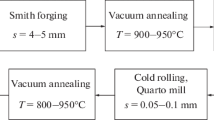An analysis of literature data on determination of the hydrogen permeability of palladium alloy V-1 membranes is given. It is shown that attention should be focused on the reliability of the specific hydrogen-permeability coefficients when performing design calculations using mathematical models to predict and analyze the optimal environment of various types of membrane devices for producing highly pure hydrogen.



Similar content being viewed by others
References
V. A. Goltsov, I. V. Frantsenyuk, N. I. Timofeev, et al., “Industrial operating experience of membrane alloy V-1 in a diffusion device for producing highly pure hydrogen from coke gas,” Vopr. At. Nauki Tekhn. Ser. At.-Vodor. Energet. Tekhn., Iss. 1, 36–37 (1987).
V. A. Goltsov, “Hydrogen in metals,” Atomic Hydrogen Energy and Technology, Atomizdat, Moscow (1978), Iss. 1, pp. 193–230.
E. Fromm and E. Gebkhardt, Gases and Carbon in Metals, Metallurgy, Moscow (1980).
R. M. Barrer, Diffusion In and Through Solids [Russian translation], Izd. Inostr. Lit, Moscow (1948), pp. 169–230.
G. S. Burkhanov, N. B. Gorina, N. B. Kolchugina, and N. R. Roshan, “Alloys of palladium for hydrogen energy,” Ross. Khim. Zh., 50, No. 4, 36–40 (2006)
M. N. Sivkov, I. N. Sakhanskaya, D. I. Slovetskii, et al., “Results of applied research on hydrogen membrane technology,” Tsvet. Met., No. 1, 36–39 (2007).
A. B. Shigirov and V. A. Kirillov, “Modelling a membrane reactor for methane vapor reforming: From granular to structured catalyst,” Teor. Osn. Khim. Tekhnol., 46, No. 2, 131–143 (2012).
Yu. K. Baichtok, V. P. Semenov, M. Kh. Sosna, and Yu. M. Baranov, “Hydrogen-permeable membrane of palladium alloy V-1 for separating hydrogen from gas mixtures,” Vopr. At. Nauki Tekhn. Ser. At.-Vodor. Energet. Tekhn., Iss. 2 (15), 26–31 (1983).
V. A. Kirillov, D. V. Meshcheryakov, O. F. Brizitskii, and V. Ya. Terent’ev, “Design analysis of low-temperature fuel element energy devices and fuel processor with hydrogen separation membrane,” Teor. Osn. Khim. Tekhnol., 44, No. 3, 243–251 (2010).
A. B. Vandyshev, V. A. Kulikov, I. V. Kirnos, and S. N. Nikishin, “High-temperature membrane devices in hydrogen recycling systems,” Khim. Neftegaz. Mashinostr., No. 11, 20–12 (2006).
A. B. Vandyshev, V. A. Kulikov, and S. N. Nikishin, “Analysis of consumption characteristics of high-throughput membrane devices for producing highly pure hydrogen,” Khim. Neftegaz. Mashinostr., No. 2, 12–15 (2010).
A. B. Vandyshev, V. M. Makarov, L. L. Myrav’ev, et al., “Modelling high-temperature membrane devices for producing highly pure hydrogen,” Teor. Osn. Khim. Tekhnol., 30, No. 5, 554–556 (1996).
Author information
Authors and Affiliations
Corresponding author
Additional information
Translated from Khimicheskoe i Neftegazovoe Mashinostroenie, No. 6, pp. 18–21, June, 2015.
Rights and permissions
About this article
Cite this article
Vandyshev, A.B., Kulikov, V.A. Hydrogen Permeability of Palladium Membranes Made of Alloy V-1 in Laboratory Investigations and Membrane Devices. Chem Petrol Eng 51, 396–401 (2015). https://doi.org/10.1007/s10556-015-0058-4
Published:
Issue Date:
DOI: https://doi.org/10.1007/s10556-015-0058-4



